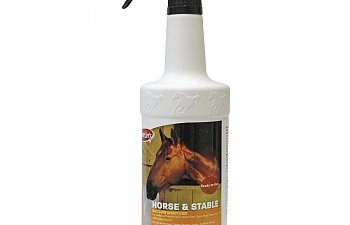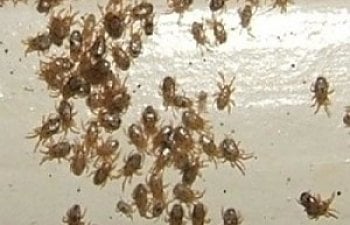
Big things can come in small packages and when it comes to Lice, Mites and other creepy crawlies they are no exception to this rule! These tiny monsters can be huge problems and spell disaster to your flock, leaving them weakened and susceptible to disease and can even lead to death. There are many different varieties of Mites and Lice as well as Fleas that can reek havoc on your flock. They feast on your birds feathers, suck their blood and eat their dander.
Where do they come from? They can come from newly added chickens or wild birds and other wildlife that drop them around your yard. And at some point in your chicken keeping hobby, it is very possible that one of your free rangers will bring one of these nasty guests home with them to the coop.
Mites:
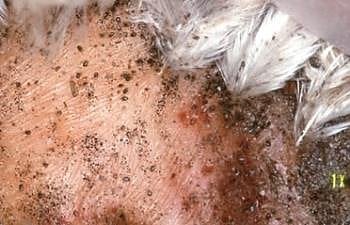
Northern Fowl Mites and Red Roost Mites are two of the most common poultry mites. These tiny, eight-legged monsters can live both on the chicken and in the coop. Red roost mites are partial to cracks and crevices in the surrounding wood of your coop, roost bars and inside nesting boxes. They come out at night to feast on your birds, returning to the cracks by morning. Northern Fowl Mites live on the bird, their entire life cycle spent on the bird's body. Depluming Mites are common, they burrow into the epidermis at the base of the feather shafts, causing intense irritation, feather pulling and loss. Feather Mites are similar to Depluming Mites and feed on quill tissue, consuming the entire base of the feather.
Lice:
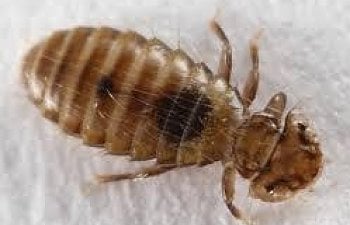
Lice come in a variety of types, the Feather Shaft Louse, the Wing Louse, the Head Louse, the Fluff Louse, the Large Chicken Louse and the Brown Chicken Louse. Larger than mites, they can easily be seen scurrying around the birds body on the skin.
Fleas:
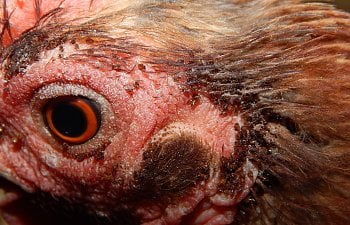
Stick Tight fleas attach themselves to a host and do not let go, hence their name, Stick Tight. They attach themselves to open skin around the face, eyes, comb and wattles. They love to lay their eggs in the bedding of the coop and nest boxes. Stick Tights can cause enough blood loss to kill the bird.
An infestation of any of these tiny tyrants can be deadly so you need to act fast! How do you know if you have an infestation?
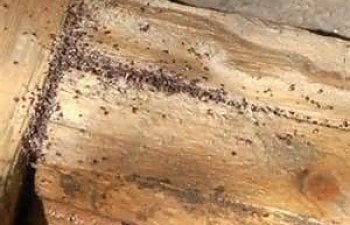
Inspecting your Flock:
Monthly inspections should be done on each and every chicken in order to keep ahead of any future troubles, you want to catch this early and treat them as quick as possible. Pay a bit more attention to your broodies as they are less likely to dust bathe as much as the other chickens, leaving them more vulnerable to external parasites. Common places to find evidence of mites is around the vent feathers, especially the feather shafts near the skin. Mites and Lice love to lay their eggs at the base of feathers, looking as if the feather shafts are dirty and clumpy. Look under wings, behind the neck. Mites can be grey, brown or red in color and can often be seen crawling around the feather shafts. Roost mites like to hang out in the cracks of your roost bar and come out at night to feast on your birds, returning to these cracks after a good meal on your birds. If you go out to your coop after dark when birds are roosting, shine a flashlight on your birds, many times you can see the mites crawling on your flock.
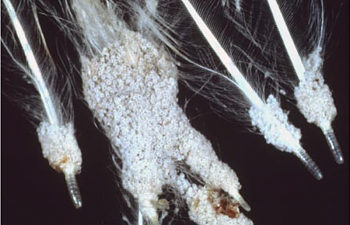
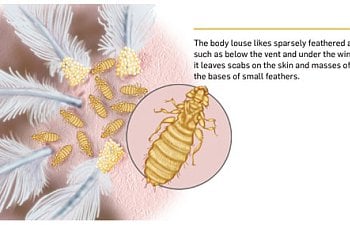
Lice are a beige color and are larger than Mites. Some lice chew, others bite, suck blood or feed on dead skin and the shed feather casings. Lice like to hide behind the back of the neck of the chicken where the birds aren't able to reach as easy to preen, under the wings and on the head of the bird. Lice are fast runners too, scurrying and skittering around! Baldness, redness of skin, scabs or peely skin. Are the bird's restless, over grooming their feathers to the point of bare shafts, any pale combs, listlessness and in some cases you can see the bird crawling in lice and mites.
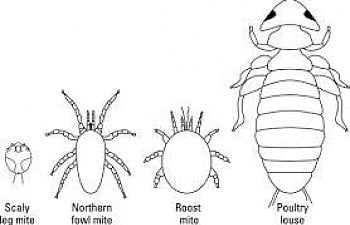
Leg Scale mites are a bit different, they get under your birds scales and suck the blood, destroying tissue right to the bone. These mites are invisible to the naked eye and are a bit more difficult to treat because you don't know they are there until they have done damage. You can tell your birds have these mites because they irritate the skin enough to raise the scales on the toes and legs of the bird. These monsters can cause your birds bone infections leading to lameness and death.
Treatments:
There are many natural treatments out there such as DE, spices, natural oils, etc... and while these may help to prevent, they won't take care of an all out heavy infestation. Permethrin is the best treatment for all of these creepy crawlies. It has a relatively low toxicity level compared to other insecticides, some which have been banned for use in poultry. You can buy Permethrin at feed stores or on line. Follow the mixing instructions on the label and mix up large amount in a bucket as you are going to spray the birds and the coop. Load up a spray bottle and spray all birds down, starting by displacing the feathers either by blowing them back or with your hand. Spray the skin and feather shafts around the vent, underneath the wings and behind the neck, all over the skin of the bird. For good measures, mist the entire bird afterwards, avoiding the eyes. You will want to treat your entire flock, even if you only see evidence on one bird.
For very severe cases where the bird is just moving and crawling with mites or lice, you might consider a "Permethrin Dip". You will definitely want to use a diluted mix of .5% in this case. (with 10% Permethrin, mix in 200ml Permethrin per gallon of water.) Never soak the bird in Permethrin, you would simply fill a large basin or tub with a .5% mix and quickly dip the bird up to the neck in the solution, avoiding the head, eyes and ears. Quickly remove the bird and towel off the excess. I recommend this only be done in the summer time when temps are high so the bird does not chill.
Next you will need to treat the entire coop. Remove all bedding from the floors and nest boxes and haul it off to a far away place. Spray the cracks and crevices of your nest boxes, tops and UNDERSIDE of your roost bars, spray the floors, corners, all of it. Permethrin only kills the live bugs and will not get the eggs of the mites or nits of the louse. So in 7 days you will need to repeat this entire procedure from bird to coop. If you had a wicked infestation, another treatment may need to be done in another 7 days following.
For Stick Tight Fleas you can physically pluck them off the bird with tweezers and dab that section of skin with a topical antibiotic cream. Dabbing the fleas directly with a weakened solution of Permethrin (.5%) will also kill the fleas. They will fall off after they die or you can pick them off yourself. You will also need to perform the same procedures as stated above on spraying birds, cleaning and spraying coop and nest boxes.
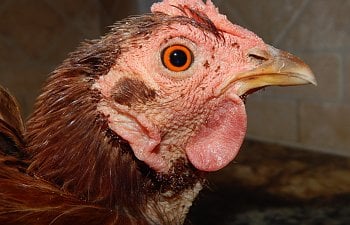
Leg Scale Mites:
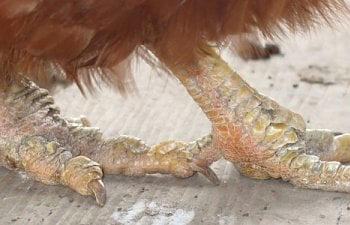
These things are much better prevented as they are quite troublesome to the birds and their keepers. I recommend 2 treatments here and have found doing both of these will give the best results. Start with Ivermectin Pour On for Cattle. It is dosed at 1/2ml for standard sized breeds, 1/4 for bantam sized birds. It is applied with a syringe (no needle) at the back of the neck directly onto the neck skin. Repeat this dosage in 10 days to make sure you have killed off any hatched eggs. For very severe cases you may need to repeat this dosage every 10 days for a month. Next, use Vaseline on the feet, toes and legs. Make sure to rub it up into the scales but be careful not to rip the scales off. Vaseline will over time smother the mites. You will need to apply Vaseline daily for a couple of weeks. In severe cases you will want to set the bird in a shallow tub of warm lightly soapy water and gently scrub off the crud on the scales first. An old soft toothbrush works well for scrubbing scales. This crud is waste from the mites. Rinse the feet and legs off with clean warm water, dry and then apply a coating of Vaseline. It can take a couple of months to heal these severe cases. Never pick at the scales, let them fall off in time. Even after mites are killed off, it can take 6 months or more for the scales to completely lay down flat. As a preventive, I recommend you Vaseline up your birds feet, toes and legs once or twice a month. These mites generally stay on the bird at all times with the exception of transferring from bird to bird. It is not necessary to tear up the entire coop for a cleaning, however I would thoroughly clean the nest boxes and spray the roost bars well.
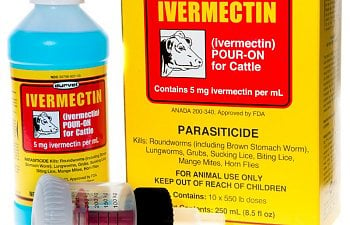
Prevention of external parasites:
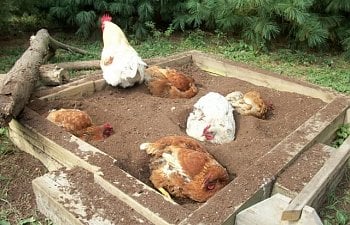
1.Your first line of defense with external mites is simple, dust bathing! Dust bathing, also called Dusting is part of the bird's preening and plumage maintenance that keeps feathers in top condition. The dust and dirt that gets worked into the feathers and skin will absorb excess oils and keep feathers from matting. Dry skin and other debris gets removed during vigorous dusting and external parasites become smothered in the dust.
Generally chickens choose their own special places to dust bathe, so many times I have tried to set up a place for them to bathe, only to have them turn up their beaks at it! But if you find their favorite dust bathing spot, you might throw a handful of DE or wood ash into the dirt. Both of which will enrich the dust bath and help ward off those nasty bugs.
2. Clean your coops and nest boxes regularly, picking up all feathers that might have eggs attached to the base of the shafts.
3. Keep up the yard around your coop, be especially careful to clean up any spilled chicken feed or treats that might attract wildlife that may be carrying parasites.
4. Do not let your birds free range in areas you might be feeding wild birds or where wild birds tend to roost at night.
5.Quarantine all new birds you are planning on adding to your flock. This not only is good practice to prevent disease but you can prevent the spread of external parasites as well.
Some of us may never have to deal with these tiny livestock, others may have regular visits from these tiny terrors. It helps to know how to spot them and treat them quickly should the need arise, your birds will feel better, lay better and live healthier lives without these creepy crawlies.
Say NO to BUGS!

Please stop by these threads for further reading and help with external parasites on your birds:
https://www.backyardchickens.com/threads/mites.1249100/#post-20039914
https://www.backyardchickens.com/threads/lice-picture.1271447/#post-20436094
https://www.backyardchickens.com/threads/lice-picture.1271447/#post-20436094
https://www.backyardchickens.com/threads/sticktight-fleas.1281280/page-2
If you need more assistance, please start a thread in our Predators and Pests forums here:
https://www.backyardchickens.com/forums/predators-and-pests.13/

